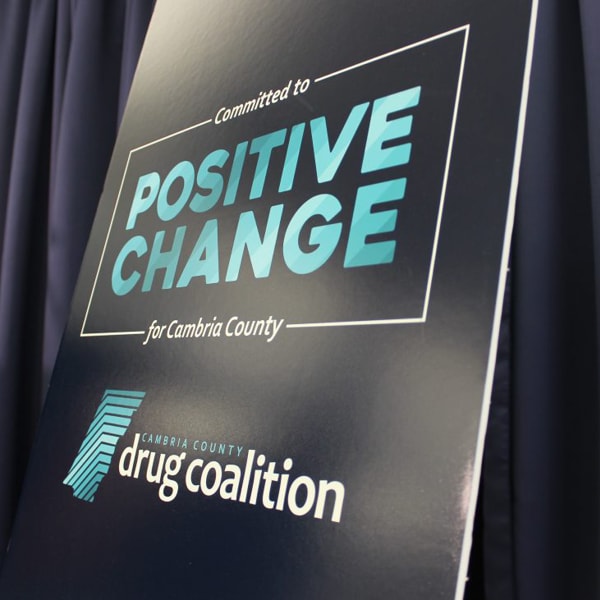Many thanks to Ronna Yablonski, Executive Director of the Cambria County Drug Coalition. She’s an endless source of ideas and has included PA Stop materials in numerous types of prevention efforts, ranging from radio campaigns to face-to-face workplace training.
1. Tell us about your organization. What do you do? Who do you serve?
I’m employed by the Cambria County Drug Coalition as the Executive Director. The Coalition is an established organization that serves to diminish drug related issues facing our county. Key area of focus include decreasing the supply of illegal drugs, improving systems of care, enhancing drug prevention, providing education, and securing funding for program sustainability. We are a formal 501(c)(3) nonprofit organization with two full time staff.
The idea is that the sum is greater than the parts. The coalition’s intentions are to bring about integrated solutions, so we employ a comprehensive plan by bringing all affected sectors of the community together for aligned and equitable action.
We are following the national Drug Free Communities (DFC) model, which identifies twelve affected sectors of the community, combined within the Communities that Care (CTC) operating system, which is our focus through our prevention services.
2. How long have you been using pa stop in your work?
We have been utilizing the materials since the formal creation of the coalition in September 2016.
3. Tell us about some of the ways that you have utilized PA Stop to spread information about opioids.
Early on, we put ads on public transit. We had a relationship with CamTran, the public transportation provider in our region. Despite the end of the transit ad funding, CamTran has continued to leave PA Stop ads on the buses that provide service across the county. That was incredible.
We did receive a Pennsylvania Commission on Crime and Delinquency (PCCD) grant that allowed us to allot a small portion of our efforts toward printed billboards.
We now are sponsoring community naloxone trainings. We extended those by thirty minutes to include a segment on “Addiction 101,” which incorporates the PA Stop family toolkits. Everybody who attends gets a family toolkit to keep, and participants can look at it in the privacy of their own home.
The toolkit is wonderfully written. I go through those like crazy. We also provide them to our local EMTs who leave them behind at homes in which they make first responder service calls. It’s a good way of continuing to get the message out.
We have a really strong healthcare leg of the coalition. They have PA Stop materials in every waiting room in the Conemaugh Health System, plus they share materials with their affiliate physicians. It’s a wonderful partnership. In fact, the local hospital has provided in-kind printing services for PAstop.org materials.
PA Stop is also used in hospital communications such as internal emails sent to staff.
We also work with our local library system. Members of the Coalition’s recovery workgroup in collaboration with members of the healthcare leg have trained staff of all county libraries on naloxone administration as well as addiction in general via utilization of PA Stop resources. Libraries are an untapped resource, I believe, across the board.
We also presented countywide teacher in-service events. County educators viewed the PAstop.org materials as a user-friendly resource.
We’ve spoken about PA Stop on radio talk shows as part of a campaign called Hearts against Heroin, created by Forever Media Broadcasting in Cambria County. It crosses six radio stations, so one minute we would be on the country radio station and the next we’d be heading down the hall for a hip hop station, then an oldies station. The broadcasting company was very excited to have Coalition collaborators from all sectors come and speak about matters linked to drug use/abuse, prevention, treatment, recovery and enforcement. It’s a unique relationship that sends a consistent message of hope and identifies resources for listeners like the ones available on the PAstop.org web site.
There are about 12 churches who are part of the coalition and about 35 churches are sharing PA Stop information.
4. What do you think are the most exciting or successful ways that pa stop has helped you achieve your mission?
There were many things about PA Stop that appealed to me. I love the campaign because I’ve been in the field of drug and alcohol prevention and education, as well as coalition-building, for 17 years and I have never seen a campaign like this in Pennsylvania. The fact that it’s a uniform strategically planned campaign makes it distinctive.
It’s beautiful that we can use the developed and approved materials. It allows not only a powerful, consistent message to be used, but also a more effective and efficient work process.
I truly do believe in the message that anybody can become addicted. This campaign helps us chisel away at stigma. The negative stigma associated with addiction prevents people from reaching out and getting the help that they need. I like the way PA Stop shows faces of people from all walks of life and all ages.
In addition, I liked that PA Stop gives you resources, it gives you action steps, and it names reliable sources for help, such as finding a link to a drug treatment center in your area by typing in your zip code. In the family resource toolkit, it says that a lot of people don’t know what to do when they themselves aren’t struggling with addiction, but a loved one is. And so it gives them action steps: they can dispose of expired drugs and get trained in naloxone.
I like the fact that it’s user-friendly, content can be understood by all readers. The “breaking the connection” message is vitally important in educating the public about the link between prescription drugs and heroin. I also like the promotion of proper drug disposal.
The level of technical assistance provided by the BOOM Creative allowed for the Coalition to demonstrate to grant funders our stewardship with invested funds. The data reports were explicit, detailed and showed the positive effects of media efforts utilizing PAstop.org billboards and online media outlets.
5. We are trying to help organizations and SCAs understand how they can use PA Stop in their communities. Do you have any advice or words of wisdom, based on your experience?
It’s as easy as clicking “download.” That’s what I would say, go to the PA Stop website and click “download.” It’s user-friendly. It has a uniform appearance and a uniform message. You can localize what you use and add your own contact information to the flyers, the billboards, the radio ads.
If funding is an issue, start by making easy asks. Everyone is looking for ways to contribute and make a difference in this epidemic. Asking people to print our materials on an in-kind basis was not a hard sell. Think about non-traditional partnerships.



